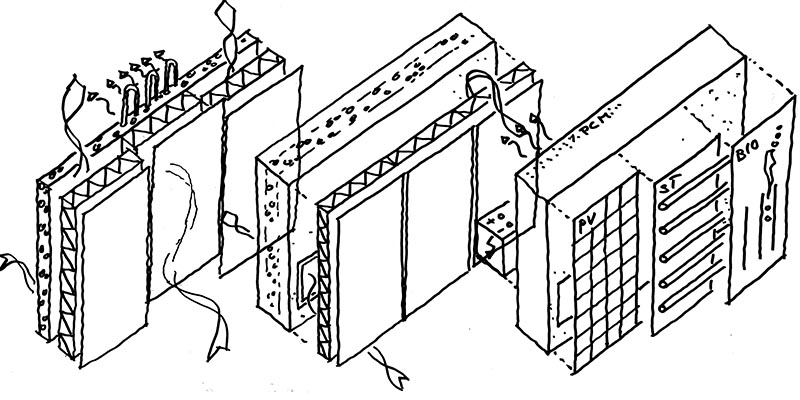Downloads
DOI:
https://doi.org/10.7480/jfde.2014.3-4.912Keywords:
Massive constructions, concrete, masonry, building envelope, integrated technology, integrated active systemAbstract
In order to generate possible scenarios about future developments of massive constructions, this paper explains the developmental paths on the basis of individual materials of clay/brick as well as concrete/lightweight concrete/aerated concrete and sand-lime brick. These construction types are organised qua development level on a roadmap, structured by a timeline and the division in massive and skeleton construction. By this development, lines of constructions appear, structured by the order of additional functionalities integrated in each development step. Following this path, possible scenarios for future developments of integrated active systems are sketched, following the line of additional functionalities being integrated in the construction. Drawbacks such as the limitation of recycling of integrated constructions and the conflict of insulation versus load bearing capacities are named. As a result two strategies are expressed: the light massive envelope construction with integral layers and the massive oriented solution with possible exchangeable components are developed and illustrated by five general construction principles.
How to Cite
Published
Issue
Section
License
Copyright (c) 2015 Ulrich Knaack

This work is licensed under a Creative Commons Attribution 4.0 International License.
Authors or their institutions retain copyright to their publications without restrictions.
References
Achtziger, J., Pfeifer, G., Ramcke, R., & Zilch, K. (2001). Mauerwerk Atlas. München, Germany: Walter de Gruyter.
Beim, A. (2004). Tectonic Visions in Architecture. Copenhagen, Denmark.
BV-Porenbeton (2013). Retrieved July 22, 2013 from http://www.bv-porenbeton.de/bvp//download/BS_Chronik-Entwicklung.pdf
Deplace, A., et al. (2005). ArchitekturKonstruieren, Basel/Boston/Berlin.
Encyclopaedia Britannica (2013). Retrieved July 7, 2013 from http://www.britannica.com/EBchecked/topic/79195/brick-and-tile
Kind-Barkauskas, F., Kauhsen, B., Polónyi, S., & Brandt, J. (1995). Beton Atlas. Düsseldorf, München, Germany: Beton-Verlag.
Klein, T. (2013). Integral Façade Construction. Towards a new product architecture for curtain walls. Doctoral Dissertation, Delft University of Technology, Faculty of Architecture. (Architecture and the Built Environment 3). Delft, Netherlands.
Knaack, U. (2011, March). About innovation. Paper presented at the Conference of Adaptive Architecture at The Building Centre, London, United Kingdom.
Knaack, U., Klein, T., Bilow, M., & Auer, T. (2007). Facades. Principles of Construction. Basel/Boston/Berlin.
Knaack, U., & Klein, T. (eds.). (2008). The Future Envelope 1: A Multidisciplinary Approach (Vol. 8). Amsterdam, Netherlands: IOS Press.
Marti, P., Monsch, O., & Schilling, B. (2005). Ingenieur-Betonbau. Zürich, Switzerland: vdf Hochschulverlag AG.
Stacey, M. (2011). Concrete: a studio design guide. London, United Kingdom: RIBA Publishing.
Tafel, E. (1981). Frank Lloyd Wright persönlich. Zürich/München: Verlag für Architektur Artemis.
Treiber, D. (2008). Frank Lloyd Wright. Basel/Boston/Berlin.
